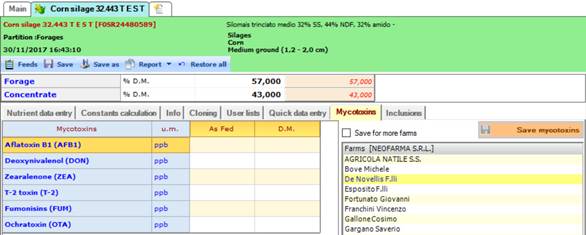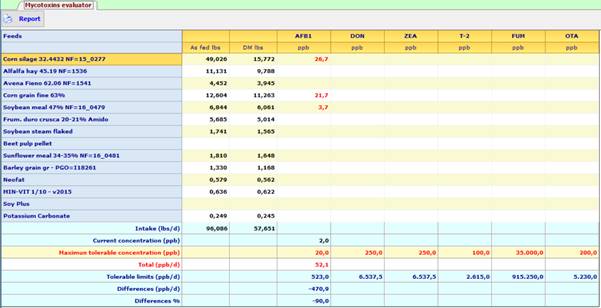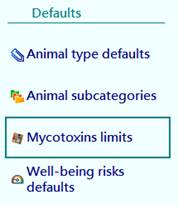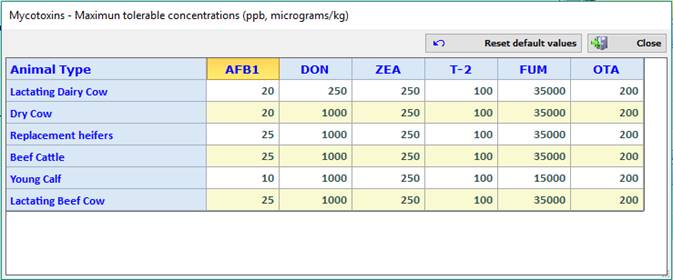
Many cereals and other feeds are susceptible to fungal attack either in the field or during storage. These fungi may produce, as secondary metabolites, a diverse group of chemical substances known as mycotoxins.
The primary classes of mycotoxins are aflatoxins of which aflatoxin B1 (AFB1) is the most prevalent, zearalenone (ZEA), trichothecenes - primarily deoxynivalenol (DON) and T-2 toxin (T-2) - fumonisins, ochratoxins (OTA) and the ergot alkaloids.
There can be wide year to year fluctuations in the levels of mycotoxins in feeds, depending on many factors, such as adverse conditions favoring fungal invasion and growth. Many mycotoxins were initially identified after they had caused a variety of subacute health problems in livestock as well as humans. With modern farming, storage and processing practices, the aim is to reduce obvious contamination, and much of our concern now focuses on chronic effects at low levels of exposure.
Even though ruminants, in general, tend to be less susceptible to mycotoxins compared with monogastrics, these metabolites exhibit a variety of biological effects in animals: liver and kidney toxicity, central nervous system effects and estrogenic effects, to name a few. Some mycotoxins, i.e., aflatoxin, fumonisin and ochratoxin, are carcinogenic.
As these toxicants can never be completely removed from the feed supply, in general have been defined levels in feeds (tolerances, guideline levels, maximum residue levels) that are unlikely to be of health concern even though the lack of a unified and transparent approach results in a wide range of guidelines/regulations.
Starting from the consideration that, from time to time, the presence of mycotoxins may render forages and feed commodities unsafe (e.g. byproducts derived from ethanol production), requiring a variety of measures to reduce risk and, therefore, monitoring for the presence of mycotoxins is needed, the development group at RUM&N developed the tool called NDS Mycotoxins Evaluator.
The tool is designed to monitor occurrence and concentrations of mycotoxins in each single feed included in the recipes, to evaluate total mycotoxins intake and concentration, comparing these values with customizable maximum tolerable limits.
The NDS Mycotoxins Evaluator should be useful to analyze and evaluate the risk of mycotoxins in the recipe in order to define the proper risks management with the goal to minimize mycotoxins effects.
Getting started
Mycotoxins feed contents
The first step should be to check the mycotoxins concentrations in the main feeds included in diet, especially those considered at greatest risk.
Testing for mycotoxins should be mostly considered when signs of potential effects on performance and health exist and cannot be readily explained. This is particularly important when moldy feeds are being fed or when marked changes in production or health have occurred among a relatively large proportion of animals.
Mycotoxins testing results can be edited and saved in the NDS through the Mycotoxins tab included in the Feeds section of the platform. Alternatively, they can also be electronically imported via the Standard XML file provided by many laboratories.
It is important to note that the values are saved at farm level in order to differentiate the values not only according to the type of feed but also based on the farm in which the contaminated feed is used. For instance, we can feed corn grain through recipes of different farms but it may not be contaminated in every farm.

Recipe mycotoxins evaluation
The NDS Mycotoxins Evaluator tool allows to monitor and evaluate the impact of mycotoxins on a recipe. Based on the amount of contaminated feeds included in the recipes, this evaluator estimates qualitative and quantitative supply of the main mycotoxins. It also compares current concentration vs. the maximum tolerable concentrations and the total mycotoxins supply vs. the tolerable daily intake limits defined for the animal type you are formulating.

Given the wide range of guidelines and regulations available around the world and the uncertainty in defining overall accepted tolerable limits, the tool allows to customize these tolerable limits for each type of cattle. The customized tolerable limits can be set through Utility tab, Defaults list of command.

